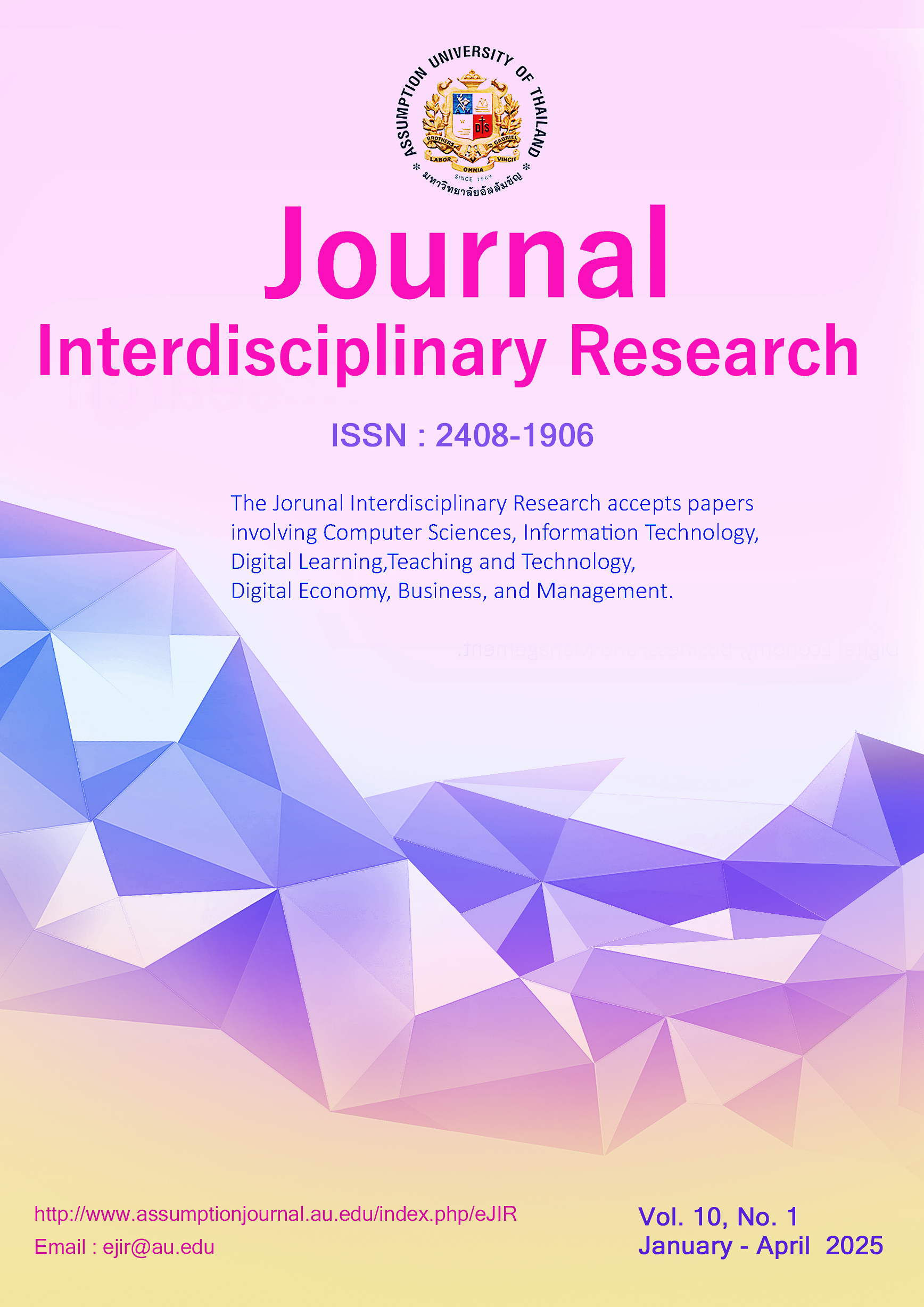Factors Influencing University Students’ English Learning Motivation: A Case Study of a Public University in Henan Province, China
DOI:
https://doi.org/10.14456/au-ejir.2025.8Keywords:
English, Motivation, Hybrid Learning, Intervention Design Implementation, EducationAbstract
Purpose: This study investigates the influence of four independent variables (Hybrid Learning, Relations between Teachers and Students, Confidence, and Proactive Personality) on one dependent variable (English Learning Motivation). Additionally, it aims to identify significant differences between variables. Research design, data, and methodology: The study employed the Index of Item-Objective Congruence (IOC) for validity and Cronbach's Alpha in a pilot test for reliability. A total of 132 valid responses from students at a public university in Henan Province, China, were analyzed using multiple linear regression to verify significant relationships between variables. Following this, a group of 40 students participated in a 12-week Intervention Design Implementation (IDI). Afterwards, quantitative results from post-IDI and pre-IDI assessments were analyzed using a paired-sample t-test for comparison. Results: Multiple linear regression analysis revealed that hybrid learning, relations between teachers and students, confidence, and proactive personality significantly impacted English learning motivation. Additionally, the paired-sample t-test demonstrated a significant difference in English learning motivation between the post-IDI and pre-IDI stages. Conclusions: This research aims to foster students' creativity by cultivating their self-leadership skills within the context of a public university in Henan Province, China.
References
Bandura, A. (1977). Self-efficacy: Toward a unifying theory of behavioral change. Psychological Review, 84(2), 191-215. https://doi.org/10.1037/0033-295X.84.2.191
Bandura, A. (1986). The explanatory and predictive scope of self-efficacy theory. Journal of Social and Clinical Psychology, 4(3), 359-373. https://doi.org/10.1521/jscp.1986.4.3.359
Bandura, A. (2001). Guide for constructing self-efficacy scales. In G. V. Caprara (Ed.), The assessment of self-efficacy (pp. 15-37). Erickson.
Bateman, T. S., & Crant, J. M. (1993). The proactive component of organizational behavior: Measure and correlates. Journal of Organizational Behavior, 14(2), 103-118. https://doi.org/10.1002/job.4030140202
Clark-Carter, D. (2010). Quantitative Psychological Research: The Complete Student’s Companion. Psychology Press-Taylor & Francis.
Crant, J. M. (2000). Proactive behavior in organizations. Journal of Management, 26(3), 435-462. https://doi.org/10.1016/S0149-2063(00)00005-6
Dörnyei, Z., & Ushioda, E. (2011). Teaching and researching motivation (2nd ed.). Pearson Education Limited.
Gardner, R. C. (1985). Social psychology and second language learning: The role of attitudes and motivation. Edward Arnold.
Hair, J. F., Anderson, R. E., Tatham, R. L., & Black, W. C. (1995). Multivariate data analysis. Prentice-Hall.
Harvey, S., Blouin, C., & Stout, D. (2006). Proactive personality as a moderator of outcomes for young workers experiencing conflict at work. Personality and Individual Differences, 40(6), 1063-1074. https://doi.org/10.1016/j.paid.2005.11.024
Li, J. Y. (1996). On teacher-student relationships and their impact on teaching activities. Journal of Northwest Normal University: Social Sciences, 3, 62-66.
Li, Q. (2021). A hybrid learning pedagogy for surmounting the challenges of the COVID-19 pandemic in the performing arts education. Education and Information Technologies, 26, 7635-7655. https://doi.org/10.1007/s10639-021-10514-7
Lin, H. (2007). Knowledge sharing and firm innovation capability: An empirical study. International Journal of Manpower, 28, 315-332. https://doi.org/10.1108/01437720710766853
Liu, C. L., Jiang, Q., Liu, J. N., & Yang, Y. T. (2020). The influence of transformational leadership on voice behavior: The roles of proactive personality, positive emotions, and negative emotions. Journal of Southwest University (Natural Science Edition), 42(6), 100-109.
Nunnally, J. C., & Bernstein, I. H. (1994). The assessment of reliability (3rd ed.). McGraw-Hill.
Pajares, F., & Graham, L. (1999). Self-efficacy, motivation constructs, and mathematics performance of entering middle school students. Contemporary Educational Psychology, 24(2), 124-139. https://doi.org/10.1006/ceps.1998.0991
Sercu, L., Méndez García, M. C., & Castro Prieto, P. (2005). Culture learning from a constructivist perspective: An investigation of Spanish foreign language teachers' views. Language and Education, 19(6), 483-495.
https://doi.org/10.1080/09500780508668659
Shen, D., & Lu, G. J. (2019). Research on the effect of "output" on English vocabulary acquisition of students in applied undergraduate colleges based on UNIPUS independent learning platform. Journal of Jishou University (Social Science Edition), 40(1), 170-177. https://doi.org/10.16551/j.cnki.1004-2570.2019.03.026
Downloads
Published
How to Cite
Issue
Section
License
Copyright (c) 2025 Wandi Liu

This work is licensed under a Creative Commons Attribution 4.0 International License.
A separate Copyright Form will be sent to authors whose paper is accepted for publication.






